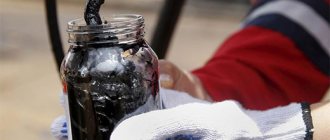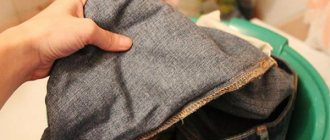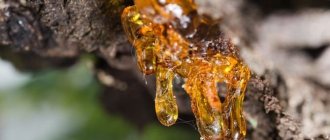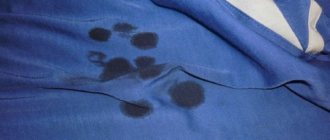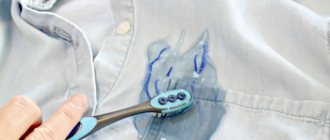Tar stains on clothes are a common problem for those who like to spend summer days outdoors, especially in the forest. Resin is sticky and attracts dirt and dust. But if you know how to remove resin from clothes, then you can get rid of stains without damaging the item. The proposed tricks are suitable for different materials and fabrics and help remove stains without leaving a trace. All you need is the availability of the necessary funds.
Preparing to wash clothes from tree resin
As in other similar cases, the rule for removing resin is that the less time has passed since the stain appeared, the easier it is to get rid of it. But you can also deal with old stains.
You should also know that if the resin was noticed immediately after it got on clothing, you should not try to remove it fresh - you cannot completely get rid of it this way, but later it will be more difficult, since it will spread out and penetrate deeper into the structure of the fabric.
In any case, you should first get rid of the thick part of the resin, and only then remove the remaining stain.
- First, you need to carefully scrape off the resin itself with a knife or blade, avoiding damage to the material.
- If something made of delicate material is dirty, you can put it in the freezer so that the resin freezes and falls off on its own. The remains can be kneaded, and then they will fall off too. If the item is large and does not fit into the freezer, you can simply cover the stain with ice, preferably wrapped in another cloth.
- Remaining resin can also be removed using heat. The stain should be ironed with a hot iron or blown with high-temperature air from a hairdryer, then covered with a napkin and ironed again, this time through it. This must be done until the resin is absorbed into the napkin.
- When the gluten from the fabric disappears completely, the item simply needs to be washed as usual. If traces remain, you can resort to folk remedies that help dissolve the remaining resin.
Alcohol
You can remove resin from clothes with regular alcohol or vodka. The method is good and safe for any thing, but not always effective.
Sometimes it is necessary to carry out several procedures to remove resin from clothing.
How to remove a stain:
- Lay the item out on a flat surface. Place a clean and preferably dense piece of unnecessary material under the contamination.
- Soak part of the bandage with alcohol or vodka and wipe the stained area. Don't be afraid, rub harder. Apply the moistened bandage to the contaminated area for half an hour. Then wipe off anything that has dissolved.
- Rinse off the residue under running water, then wash the item using powder and fabric softener.
Alcohol, unlike vodka, can not only remove resin from clothes, but also corrode the dye.
If the pine resin stain is still fresh, then the most effective way to get rid of the stain is to use alcohol and a cotton pad.
After which the “saved” item is sent to the washing machine.
This method will be effective even for light-colored items, since they are not afraid of the effects of the alcohol base.
How to wash resin using traditional methods
Specialized store-bought products for dissolving tar stains on fabric are unpopular and expensive, but there are a number of folk recipes that help get rid of such stains and keep clothes in good shape. To avoid unexpected troubles, you first need to test the selected substance on an area of the fabric that is not noticeable. This is necessary in order to make sure that the product will not spoil the material: it will not corrode it, will not wash out the paint, will not leave streaks. If any of this happens, you need to choose a different cleaning agent. In the case of delicate fabrics that require special handling, it is better to contact a dry cleaner, where the problem will be solved quickly. For simpler cases, you can use one of the proposed substances available in the house or within walking distance.
Turpentine + alcohol
Apply turpentine to the stain and leave for half an hour. Then use a cotton swab dipped in alcohol to wipe the stain until it completely disappears. To eliminate the remaining pungent odor, after the procedure it is enough to wash the item as usual.
Coca Cola
You can soak the item or stained area in regular, undiluted Coca-Cola for half an hour or an hour, and then simply wash it. It is not advisable to use other carbonated drinks, because they can leave streaks, but a positive effect may not be achieved.
Dishwashing liquid
First you need to drip sunflower oil onto the stain and leave it for half an hour. Then wipe it with a cotton swab and apply dishwashing detergent. Then you can wash it off with plain water.
Instead of dish soap, you can use a soap solution, although this is more important for the skin.
Refined gasoline
It is enough to keep the item in purified gasoline, then wash it as usual to eliminate the smell (you may need to do this more than once).
Important! You need purified gasoline, purchased in a special store, and not regular gasoline intended for refueling cars, which corrodes fabric and leaves streaks.
Acetone
You can use regular acetone or nail polish remover. They need to wet a napkin and gently rub the stain with it until it disappears completely. It is necessary to repeat the procedure in several stages, between which it is necessary to pause for several hours - acetone may not dissolve the resin immediately, but over time.
We recommend:
How to wash white clothes
Most of the suggested cleaning agents may leave an unpleasant odor. Getting rid of it is simple: after cleaning, just wash the item with regular washing powder or use any fabric care product. If this does not help, then you can hang it out in the cold or place it in the freezer and then ventilate it. In any case, sooner or later the smell will go away on its own, and the proposed methods only help speed up this process.
Removing unpleasant odors and stains
Almost all resin removal products have a strong and sometimes unpleasant odor. It is also possible that whitish or yellow stains may appear.
A paste of water and mustard powder will help remove stains. The surface is treated with it for twenty minutes. Next, the clothes are soaked in soapy water or washing powder for an hour and washed in a washing machine in the appropriate mode for the fabric.
Hydrogen peroxide will remove yellow stains on light-colored fabrics. To do this, you need to soak the clothes in water with half a bottle of peroxide for thirty minutes and wash them in an automatic wash.
One option is hydrogen peroxide.
The smell can be easily removed with double the amount of fabric softener; in extreme cases, the item can be soaked in it for twenty minutes. Next, be sure to dry things well, ideally outside.
It is very easy to get trouble in the form of drops of resin on your clothes; just sit on a bench under a poplar tree or on a fresh cut of a pine tree. People who work with artificial polymers also regularly have to remove traces of them from their work clothes.
But, as practice shows, it is quite possible to clean things. To do this, it is enough to select a method or product directly for the material of the soiled item.
We use solvents
If the stained fabric is not considered delicate, you can clean it using a special solution, which consists of:
- 4 drops of ammonia;
- 4 drops of turpentine;
- teaspoon starch.
After thoroughly mixing the ingredients, the mixture should be applied to the stain and wait until it is completely dry, and after a while, scrape it off with a stiff brush. It is possible that traces of resin will remain after this, and then the procedure should be repeated again.
Bitumen stains
Bitumen or tar is used in road construction and roofing work. Stains from leather items can be easily removed with vegetable oil, but it is more difficult to clean denim trousers or other clothes from such stains.
Natural dense fabrics are cleaned of bitumen with gasoline, acetone or white spirit. The liquid is poured onto the stain, and after a few minutes, when the resinous substances have softened, it will be possible to wipe off the dirt with a cotton swab.
But things made from synthetics are more difficult to save. A good result cannot be guaranteed, since those substances that dissolve bitumen can also dissolve fabric fibers.
You can try to remove the stain with the same substances that are used for natural fabrics. But you should be prepared for the fact that the product can be damaged; an irremovable light stain or hole will appear on the fabric.
What not to do with a resin trace
Before choosing how to remove tree sap from clothes, you should consider some important factors, otherwise, through negligence, you can damage the item irrevocably.
- Before using one of the suggested cleaning methods, you need to scrape off the resin itself. All the proposed options are aimed at getting rid of its traces, but none of them will help get rid of it completely, without preliminary cleaning.
- Brightly colored items made from delicate materials should not be cleaned with alcohol or any acids, because they can discolor the fabric at the point of contact.
- Vinegar, even diluted with water, should not be used on silk fabric.
- Strong alkaline solvents and especially bleaches are safe to use only for white things, otherwise the color will begin to peel off.
- Turpentine or gasoline are only suitable for rough fabrics. It is rational to use them for jackets, trousers and other things that do not require careful handling. They are also most suitable for hiking clothing, which is made from durable materials - gentle products may be ineffective.
- To prevent the stain from spreading further during the cleaning process, you can moisten the cloth around it with plain water or sprinkle it with starch/talcum powder.
- The directions of movements when cleaning should be from the edge to the center, and not vice versa, otherwise the dirt will spread and be firmly absorbed.
- It is advisable to clean from the inside out and move to the front side. Before doing this, make sure that the fabric is not discolored.
- It is not advisable to leave the product on for longer than the recommended time, otherwise it may begin to corrode the fabric.
Since resin can be dissolved using different methods, the item stained with it will not be damaged forever. It is only important to know which methods are suitable for a particular material, as well as to have the necessary tools at hand. Even for delicate fabrics there are safe options with which the item will return to its normal state. In any case, you shouldn’t worry and throw away the item if there is a chance to save it. There are many ways to get rid of tar stains, and one of them will definitely help.
Rate this post
Delete it once or twice
The previous methods will be relevant for delicate fabrics that simply cannot be handled harshly.
If you are looking for how to remove resin from old clothes, or from a pair of jeans, study the following recommendations.
Alcohol
This is not only a disinfectant, but also an excellent solvent that should be in every housewife’s arsenal to get rid of stubborn stains.
Soak a cotton pad in alcohol, rub the stain if it is fresh, or leave the swab on the fabric for 20 minutes if the substance has already hardened for a long time.
The same principle applies to acetone, kerosene, turpentine and gasoline.
After applying lotions made from compounds with a strong odor, keep the item under running cold water for a while, and then wash it in a machine using conditioner.
Bomb mixture: turpentine-ammonia-starch
This paste can save clothes made from delicate and natural fabrics.
You will need:
- 1 tbsp. l. potato starch,
- 1 tsp. turpentine,
- 1 tsp. ammonia.
Mix everything and apply to the product for 12 hours. After time has passed, clean off the dried solution along with the resin juice.
Soda
Do you know the difference between an experienced housewife and a young one? A set of life hacks. Obviously, not every woman knows how to clean pine resin from clothes. And we’ll give you a hint – Coca-Cola.
The composition of this carbonated drink is kept in the strictest confidence, but it should be sold in departments with household goods rather than in soft drinks.
We have already told you that with the help of Cola you can clean the inside of a kettle from scale, and now you can clean forest gifts from things.
The instructions are incredibly simple: pour magic nectar into a basin, soak the little thing in it for 5 hours, and then wash it in the machine.
Vegetable oil
This product is suitable for leather products. For example, if a tree in the forest marks your favorite biker jacket, do this:
- Dip the sponge into the oil;
- Apply it to the contaminated area;
- After 20 minutes, wipe clean with soapy water.
Dishwashing liquid
Will save woolen products. Take the oil to join him and do everything as in the previous point, only instead of soap, apply detergent at the end. The final step is traditionally machine washing.
White spirit
Considered the best solvent. It will help remove not only resin traces, but also rosin and bitumen. An indispensable item for skilled men.
After treatment, you need to wash thoroughly with powder and conditioner.
Stain remover
Sometimes he will be able to solve such a problem. Soak for a while, and then send to wash. If the problem persists, return to one of the steps above.
The nuances of cleaning various things
The resin removal technique can be influenced not only by the quality of the fabric, but also by the cut of the product.
- Light underwear (T-shirts, dresses, shirts, blouses) do not require special preparation before cleaning. To remove a stain, it is enough to place a plastic or wooden board under the contaminated area so that the reagent does not get on the clean part of the product.
Items made from thicker fabrics (shorts, trousers) can be cleaned using organic solvents, heating, and cooling.
In this case, it is necessary to pay attention to the reverse side, which is also impregnated with resin. Brushes and hard sponges are used to remove resinous particles from these clothes.- Outerwear (jackets, windbreakers, coats) requires preliminary stripping of the lining. processing is also carried out on the front and back sides. After washing, which completes the cleaning process, the lining is sewn into place.
- Shoes (sneakers, shoes, boots) are cleaned of resin, taking into account the nature of the material. If it is rubber, natural or artificial leather, use oil or kerosene. Shoes made of suede and nubuck are cleaned with starch or using professional products.
This publication will tell you about removing tar stains from jeans, and this one from trousers.
How to remove super glue from clothes
Working with any type of adhesive requires extreme caution. Due to their properties, they leave difficult-to-remove contaminants on the surface of almost any material. Super glue is very difficult to remove from fabric, and it is generally impossible to wash with soap or powder (especially high-quality, not Chinese). You can remove it (before it starts to dry out) with gasoline, paint thinner or nail polish remover (acetone helps even with dried stains). Before removing glue from silk or wool clothing, make a solution (20 ml per 40 ml) of vinegar and water.
How to remove Moment glue from clothes
There are many methods for removing stubborn glue stains. For durable fabrics, use gasoline, a solution of vinegar in water (one to one), and acetone. More delicate materials: chiffon, silk or guipure, velvet, lace and wool require a special approach. You can remove glue stains from such fabrics with a special gentle solution, to obtain which, dilute 20 g of citric acid in 200 ml of water. Use a swab soaked in the solution to soak the stain, then wash the product. Some types of Moment glue are easily removed after freezing (fresh) or heating (dry stains).
Prohibitions on cleaning
If you notice an area stained with resin on your clothing, you should try to avoid a number of common mistakes:
- You should not try to wipe off the resin with your hands - this will only smear the sticky mass on the fabric even more and stain your hands.
- Simply putting a resin-stained item in the washing machine is not an option. Regular washing will not help remove the stain completely, without additional treatment, and this approach can lead to staining of other things.
- Do not leave solvent or other cleaning agent on the fabric for longer than recommended. This can lead to damage to things and fading of colors.
Oil + dishwashing liquid
Fresh resin that has not had time to dry is the easiest to clean. The detergent has degreasing properties, so it is used to remove oil stains. You can wash clothes using the following method:
- Treat the damaged area with oil. Wait 30 minutes.
- Pour in dish soap.
- Leave to soak for 30 minutes.
- Wash everything off and rinse the product.
Advice! To remove resin from skin, wool or fur, just wait 5 minutes. Then remove the remains with a napkin.
Coca Cola
Coca-Cola contains phosphoric acid, which will help clean the product in the shortest possible time.
Method 1
Moisten the damaged area generously and wait 2-3 hours. You can soak the item completely. When the resin gets wet, rub the stain with a brush and rinse.
Method 2
This method is more gentle. Wash off the dirt with a cotton swab soaked in Coca-Cola and leave for 20-30 minutes. Rinse and wash.
Instead of cola, you can take Fanta, Sprite. To remove traces of resin from light-colored fabrics, you need to use colorless sparkling water.
Attention! This method is not suitable for cleaning white items. They may lose their whiteness.
Additional Tips
Removing resin is a delicate process that depends on many factors. Therefore, when cleaning, you should remember the following important recommendations:
- It is necessary to start cleaning immediately after the appearance of resinous contamination. This increases the chances of complete preservation of the color and structure of the fabric.
- It is best to dry clean expensive items immediately. Home experiments can ruin the appearance of an exclusive item.
- The chosen product should be tested on an inconspicuous area of clothing. This will protect it from damage if the reagent turns out to be aggressive towards the material.
- After the stain has been removed in one way or another, the item is washed manually or automatically.
Recipes and tips for removing resin from various surfaces are presented in this section.
Features of spots
Wood resin is a product of organic origin. The sap secreted by trees has a thick consistency and complex composition.
Wood tar is viscous and oily, and has a brown color. Resin is formed during the hardening process of pine sap.
Fresh and hardened resin from coniferous trees actively reacts to heating and freezing. This circumstance can be taken advantage of, especially in cases where it was not possible to remove the resinous drop before it set.
Freezing makes the resin brittle. In this state, it crumbles easily and can be removed from the material quite easily.
Removal methods using heating are more complex in technology and are not suitable for processing synthetic fabrics and other materials that do not tolerate heat.
The item needs to be prepared for heat treatment:
- If the stained clothing has a lining, it is paired so that the fabric with the stain is in one layer.
- Before you handle the iron, you need to apply napkins with good absorbency on both sides of the stained area.
- As the resin warms up and is absorbed, they will need to be replaced with new ones.
In addition to pine, other trees also release resin - larch, spruce, thuja, etc.
